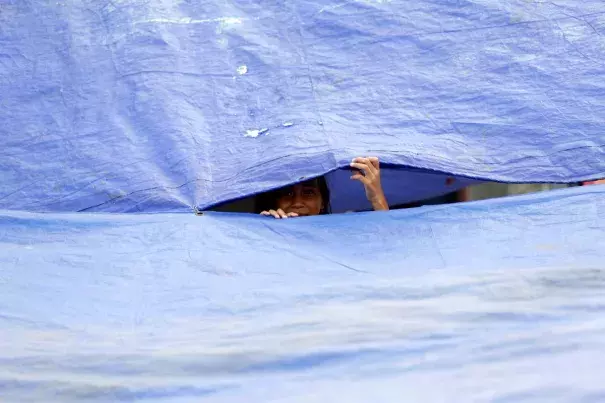Headline
Indonesia seeds clouds to keep them away from flooded capital
Jakarta, Indonesia

A girl looks out between two tarps at a temporary shelter after floods in Jakarta, Indonesia. Credit: REUTERS/Ajeng Dinar Ulfiana
Signals Summary: Climate change is making extreme rainfall more common by increasing ocean evaporation and the amount of moisture the atmosphere can hold.
Article Excerpt: Indonesia’s air force seeded clouds with salt on Friday to try to stop rainfall reaching the slowing sinking capital after deadly flash floods and landslides triggered by some of the heaviest rain ever recorded.
The death toll in Jakarta and surrounding areas rose to 43 as of Friday, the disaster mitigation agency said, while tens of thousands of people have been displaced.
...
The floods followed torrential rains on Dec. 31 and into the early hours of New Year’s Day that inundated swathes of Jakarta and nearby towns, home to about 30 million people.
The deluge at the start of 2020 was “one of the most extreme rainfall” events since records began in 1866, the Meteorological, Climatological and Geophysics Agency (BMKG) said on Friday.
The agency said climate change had increased the risk of extreme weather and warned that heavy rainfall could last until mid-February, with Jan 11-15 an expected peak.
Related Content
Science Source
| Proceedings of the National Academy of Sciences
Human influence has intensified extreme precipitation in North America
Megan C. Kirchmeier-Young and Xuebin Zhang
Science Source
| Science Advances
Unprecedented climate events: Historical changes, aspirational targets, and national commitments
Noah S. Diffenbaugh, Deepti Singh, and Justin S. Mankin
Science Source
| American Meteorological Society
Precipitation Extremes: Trends and Relationships with Average Precipitation and Precipitable Water in the Contiguous United States
Kenneth E. Kunkel, Thomas R. Karl, Michael F. Squires et al
Science Source
| Nature Communications
Social inequalities in climate change-attributed impacts of Hurricane Harvey
Kevin T. Smiley, Ilan Noy, Michael F. Wehner et al


